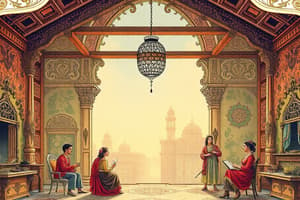Podcast
Questions and Answers
What was the primary outcome of the Viet Minh's victory at Dien Bien Phu?
What was the primary outcome of the Viet Minh's victory at Dien Bien Phu?
- Expansion of British colonial rule
- Control over North Vietnam (correct)
- Formation of the Communist Party of Vietnam
- Control over South Vietnam
Which leader was associated with the Great Leap Forward in China?
Which leader was associated with the Great Leap Forward in China?
- Ho Chi Minh
- Deng Xiaoping
- Mao Zedong (correct)
- Lao Tzu
Which of the following was a key factor in ending Apartheid in South Africa?
Which of the following was a key factor in ending Apartheid in South Africa?
- Imposition of sanctions by Britain
- Support from the United States
- Role of Nelson Mandela (correct)
- Influence of the African National Congress (correct)
What was the purpose of the Cultural Revolution in China?
What was the purpose of the Cultural Revolution in China?
Which leader was deposed with the support of the United States in South Vietnam?
Which leader was deposed with the support of the United States in South Vietnam?
What significant event occurred in 1979 in Iran?
What significant event occurred in 1979 in Iran?
Who was the female Prime Minister of India in 1966 known for her political acumen?
Who was the female Prime Minister of India in 1966 known for her political acumen?
Which group is considered an Islamic Fundamentalist organization in Egypt?
Which group is considered an Islamic Fundamentalist organization in Egypt?
What was one of the significant challenges faced by newly independent nations in Africa after colonization?
What was one of the significant challenges faced by newly independent nations in Africa after colonization?
Which country experienced military takeovers during the 20th century among those listed?
Which country experienced military takeovers during the 20th century among those listed?
What was the consequence of Fidel Castro's revolution in Cuba?
What was the consequence of Fidel Castro's revolution in Cuba?
Which factor contributed to the sluggish advancement of women's rights in various regions by the 1950s?
Which factor contributed to the sluggish advancement of women's rights in various regions by the 1950s?
What major economic issue confronted the new West African nations due to colonial legacy?
What major economic issue confronted the new West African nations due to colonial legacy?
What was a notable feature of the governance in South Korea after the Korean War?
What was a notable feature of the governance in South Korea after the Korean War?
What pattern of leadership is most prominent in post-colonial African nations?
What pattern of leadership is most prominent in post-colonial African nations?
In Latin America, what role did military governments often play in the 20th century?
In Latin America, what role did military governments often play in the 20th century?
Which of the following best describes the socio-economic situation of women in the 1950s in Latin America?
Which of the following best describes the socio-economic situation of women in the 1950s in Latin America?
What impact did the Great Leap Forward have in China under Mao's leadership?
What impact did the Great Leap Forward have in China under Mao's leadership?
Flashcards
Ngo Dinh Diem
Ngo Dinh Diem
US-supported leader of South Vietnam in the 1950s, later deposed by the US.
Ho Chi Minh
Ho Chi Minh
Most important Vietnamese Communist leader, led the fight for Vietnamese independence.
Viet Minh
Viet Minh
Communist-dominated nationalist movement in Vietnam in the 1940s, supported by China.
Dien Bien Phu
Dien Bien Phu
Signup and view all the flashcards
Green Revolution
Green Revolution
Signup and view all the flashcards
Apartheid
Apartheid
Signup and view all the flashcards
Cultural Revolution
Cultural Revolution
Signup and view all the flashcards
Great Leap Forward
Great Leap Forward
Signup and view all the flashcards
Latin America in the 20th Century
Latin America in the 20th Century
Signup and view all the flashcards
Military Government in Latin America
Military Government in Latin America
Signup and view all the flashcards
Cuba in the 20th Century
Cuba in the 20th Century
Signup and view all the flashcards
U.S. Presence in Latin America
U.S. Presence in Latin America
Signup and view all the flashcards
Women's Rights in Latin America
Women's Rights in Latin America
Signup and view all the flashcards
Post-Colonial Challenges in Africa
Post-Colonial Challenges in Africa
Signup and view all the flashcards
Women's Rights in Post-Colonial Africa
Women's Rights in Post-Colonial Africa
Signup and view all the flashcards
Neocolonialism in Africa
Neocolonialism in Africa
Signup and view all the flashcards
Government Responses in Post-Colonial Africa
Government Responses in Post-Colonial Africa
Signup and view all the flashcards
The Cold War Era in the Middle East
The Cold War Era in the Middle East
Signup and view all the flashcards
Study Notes
Latin America: Revolution and Reaction into the 21st Century
- Issues included social justice, cultural autonomy, and economic security
- Workers' organizations became a political force
- Urban growth and emigration
- Talk of change but little actual change occurred
- Transformations in education, social services, women's rights, and industry
- Military governments frequently occurred
- The Catholic church, liberation theology, and socialism held significant political sway
- Military rule was often seen as a solution to problems
- Brazil, Argentina, Chile, Uruguay, and Peru experienced military takeovers
- By the 1970s, democracy returned to Argentina, Brazil, Nicaragua, Guatemala, Colombia, and Peru
- Cuba remained under American influence following Spanish rule
- Cuba was a major sugar exporter
- Class disparity was evident
- Fidel Castro attempted a revolution in 1953
- By 1958, military ruler Batista was out
- In 1961, the U.S. severed relations with Cuba
- Threats of nuclear war emerged in 1962
- Continuing Soviet aid to Cuba
- The U.S. presence served to protect economic, strategic, political and ideological interests
- Tensions lessened after 1930
- Women's suffrage became more widespread by the 1950s
Africa, the Middle East and Asia in the Era of Independence
- Post-colonial challenges included ethnic and religious divisions
- Lack of technological and management expertise was prevalent
- Population growth was rapid
- Degradation of the environment was a significant concern
- Corruption was a problem
- Military dictatorships were common
- Mass urban migrations created parasitic cities
- Women's rights were often promised but dominance remained with men
- Inferior education for women and girls
- Religious fundamentalism was a factor
- Sanitation and famine were major challenges for women and children
- Few prominent women emerged in India and Pakistan.
Neocolonialism and the Philippine politics
- Industry suffered due to limited capital
- Exporting cash crops generated uncertain revenue
- Government spending relied on revenue
- Arbitrary boundaries caused civil strife
- Aid from developed countries demanded political and economic concessions
- Leaders blamed colonial influences for problems
- New West African nations faced challenges
The Middle East in the Cold War Era
- Iran's revolution led by Ayatollah Khomeini
- Overthrows the Shah
- Religious fundamentalism gained sway with Islamic law
- The West was seen as an enemy of the people
- Devastating wars with Iraq highlighted failed Cold War efforts
Apartheid
- African "homelands" were a feature of apartheid
- ANC, led by Nelson Mandela, confronted and ended white rule
- External and internal pressures influenced white rule cessation
- Colonial divisions in Africa led to the emergence of new nations
- India's democracy mirrored early decentralized models
- Middle Eastern tensions showed religious and secular divisions
- African rulers were authoritarian, mirroring "Big Man" rule traditions.
Rebirth and Revolution: Nation-Building in East Asia and the Pacific Rim
- Post-War Japan experienced American occupation
- Democracy with a constitution and two party system was instituted
- Emperor became a figurehead
- Military was disbanded
- New education system created
Issues in Korea, South Korea and Vietnam
- Women's traditional status remained
- Some political corruption
- Economic downturns and unemployment patterns existed
- Cold War divisions between U.S. and U.S.S.R. exacerbated tensions
- War efforts in North Korea resulted in a dictatorial state
- South Korea became an industrialized powerhouse
- Pacific Rim nations experienced stable and vigorous economies
- Hong Kong's return contributed to China's influence
- Strong economic growth was visible in Indonesia, Thailand, and Malaysia
- China implemented solutions and addressed social and economic problems
Globalization
- Green Revolution introduced agricultural improvements like seed, fertilizer, and irrigation in Asia.
- F. W. de Klerk, South African Prime Minister, played a role in ending apartheid in the late 1980s.
- Benazir Bhutto was twice elected Prime Minister of Pakistan in the 1980s
- Key figures like Nelson Mandela and Jawaharlal Nehru were important to their respective countries' independence movements
Studying That Suits You
Use AI to generate personalized quizzes and flashcards to suit your learning preferences.
Related Documents
Description
Test your knowledge on the significant social, political, and economic changes in Latin America from the 20th century into the 21st. This quiz covers key events like military rule, revolutions, and the role of the Catholic Church and socialism in shaping the region's history. Explore how these elements influenced social justice and cultural autonomy across countries such as Brazil, Argentina, and Cuba.




